Art & Exhibitions
De Young Museum’s New Fashion Exhibition Lets Visitors Don Historic Designs With Snap’s A.R.
"Fashioning San Francisco: A Century of Style" features more than 100 garments and an A.R. experience by Snap.
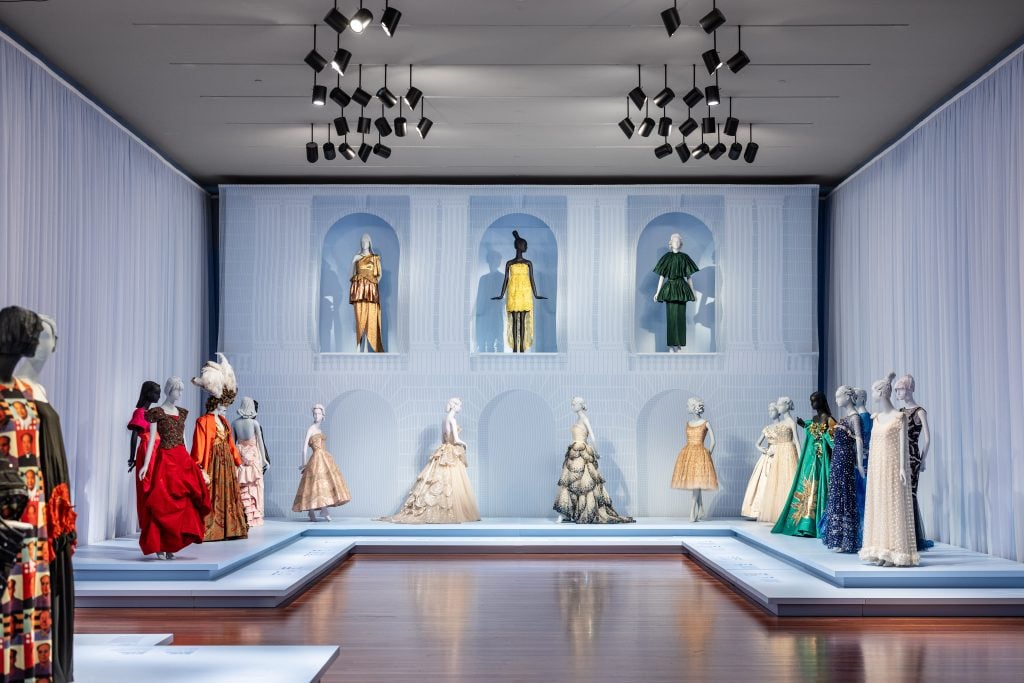
"Fashioning San Francisco: A Century of Style" features more than 100 garments and an A.R. experience by Snap.

Min Chen

One of the first dresses that Yves Saint Laurent designed for the house of Dior, the 1955 “Soirée de Paris” is a form-fitting number, masterfully crafted in black silk velvet and cinched at the waist by a long satin bow in contrasting beige. The historic garment is now on view at “Fashioning San Francisco: A Century of Style,” the newly opened exhibition at de Young Museum in San Francisco. It cuts an elegant figure on a mannequin. Might it look as good on you? Well, you don’t have to pull the dress off the display platform to find out.
In a room just downstairs from the exhibition is an installation that allows you to “try on” said outfit using Snap’s augmented reality technology. The space is loosely divided into three segments, each fitted with a huge screen that Snap terms a mirror. Stepping in front of each of these mirrors, you can glimpse yourself draped in the Saint Laurent dress or two other ensembles, one by Valentino and another by Bay Area designer Kaisik Wong.
Of course, Snap’s A.R. doesn’t just slap the outfit onto an image of you and call it a day. Move and the virtual clothing moves with you; twirl and it spins along. When you first step into frame, the piece even fades in on your physical body, with tiny animated sparkles to project Cinderella-esque magic. I was particularly taken with how the Saint Laurent dress flowed and the Valentino gown conveyed heft, despite their obvious virtuality.
“When you walk into a museum, you’re looking at the piece of art on the wall or the dress on the mannequin,” Rajni Jacques, Snap’s global head of fashion and beauty, told me in a walk-through. “But with augmented reality, you’re engaging with it, which remixes the storytelling and experience of going to a museum.”
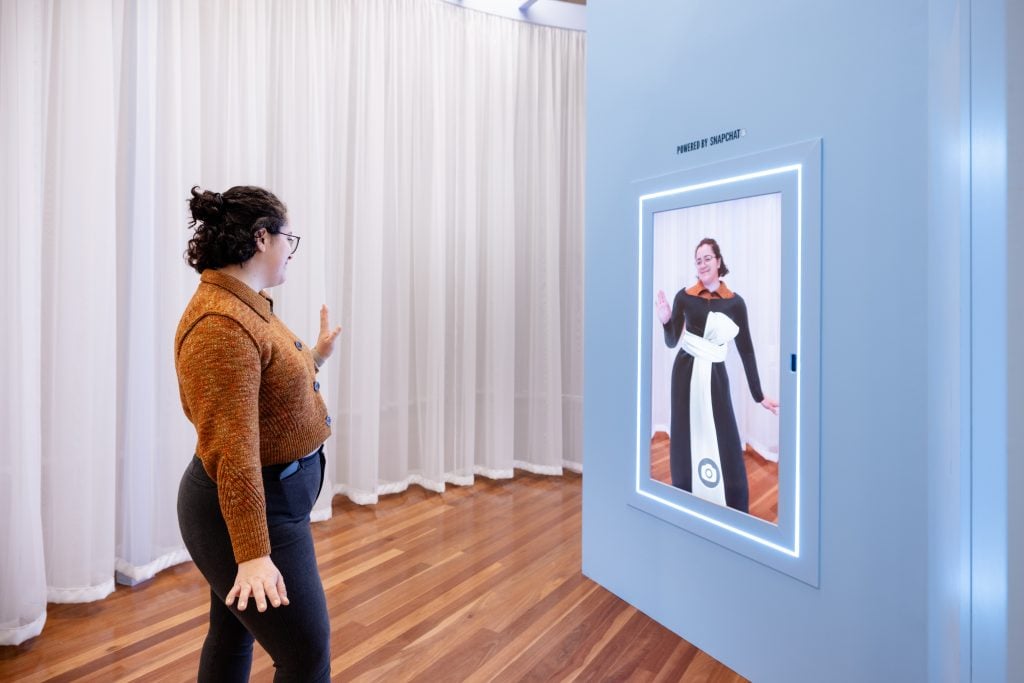
The A.R. try-on experience by Snap accompanying “Fashioning San Francisco: A Century of Style” at de Young Museum. Photo: Gary Sexton, courtesy of the Fine Arts Museums of San Francisco.
This installation represents the first time that Snap’s A.R. mirrors have appeared in a cultural institution in the U.S. More often, the technology can be found in commercial or retail contexts. Its appearance at de Young, said museum director Thomas P. Campbell, serves both engagement and educational purposes (in the same way the museum’s 2022 Ramses exhibition leveraged virtual reality).
“Our digital team had the idea of democratizing the exhibition by letting our visitors try on the clothes,” he told me. “It allows people to visualize themselves in these garments and helps them understand these dresses in a different way.”
The A.R. activation is also aptly pegged to the museum’s latest exhibition, he added. After all, it’s not every day the museum brings these historic, often delicate garments to light—much less into the future with a high-tech boost. The show, in fact, marks the first time in more than three decades that de Young has presented its enviable costume collection, which it began building in 1895.
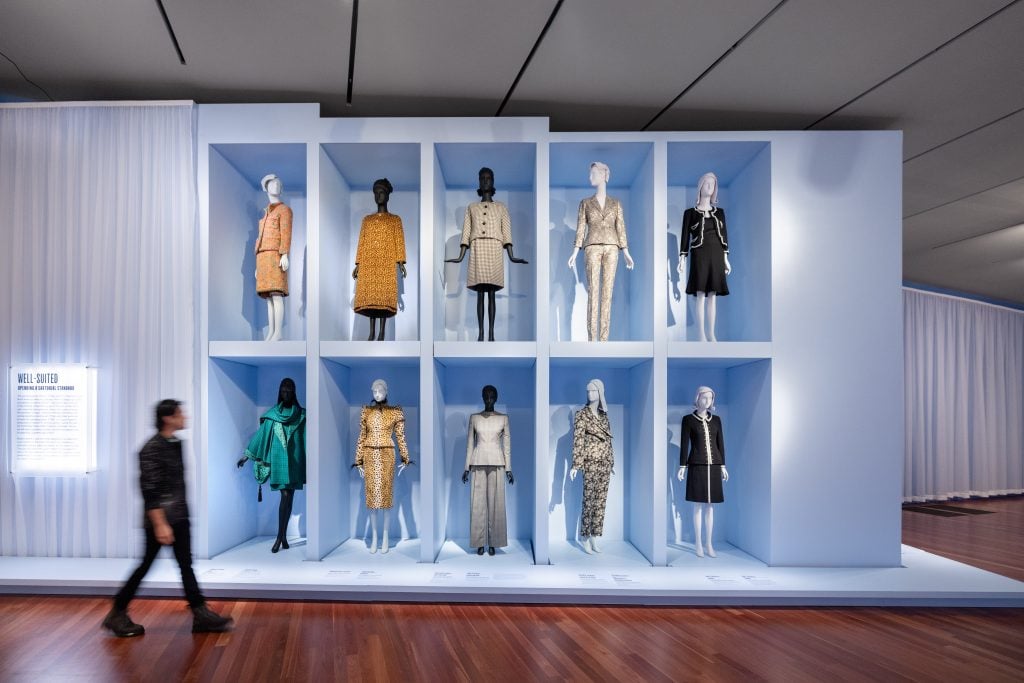
Installation view of “Fashioning San Francisco: A Century of Style” at de Young Museum. Photo: Gary Sexton, courtesy of the Fine Arts Museums of San Francisco.
For “Fashioning San Francisco,” the museum is displaying 100 pieces—by the likes of Alexander McQueen, Issey Miyake, Pierre Balmain, Christian Lacroix, Comme des Garçons, and more—from its storied collection in a bid to trace the city’s history through fashion. It’s an expansive remit but one within which the show’s curator, Laura L. Camerlengo, sees a clear throughline.
“We’re looking at about 100 years of fashion, considering the great 1906 earthquake in the city as a starting point,” she told me during a sneak preview of the exhibition. “Fashion becomes a way of showing resiliency in the wake of disaster, and it connects to the importance of philanthropy in the city.”
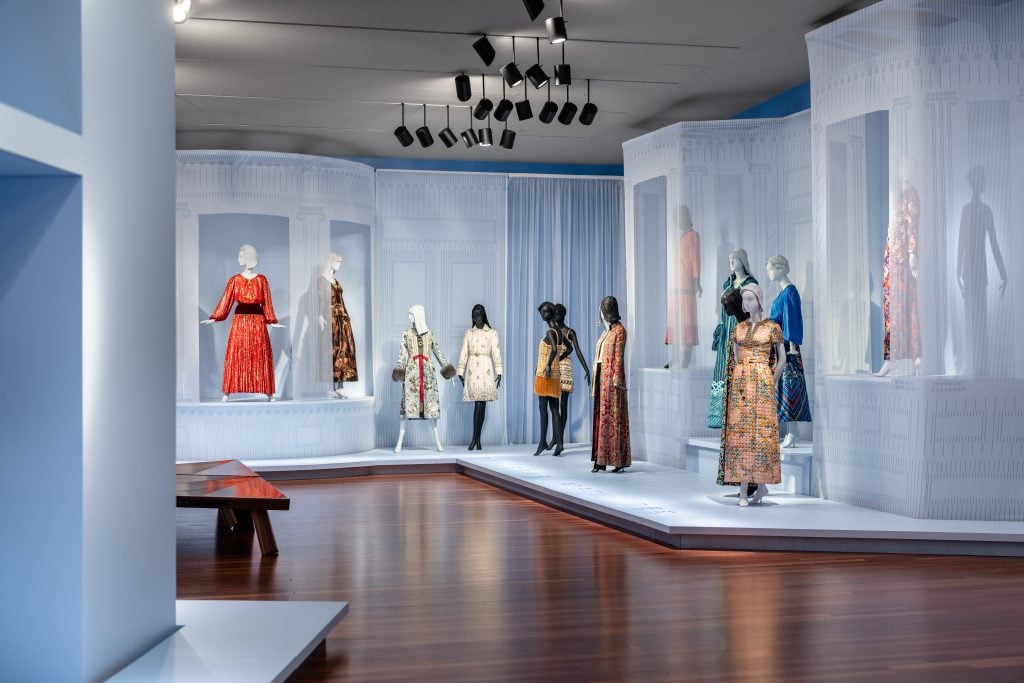
Installation view of “Fashioning San Francisco: A Century of Style” at de Young Museum. Photo: Gary Sexton, courtesy of the Fine Arts Museums of San Francisco.
That philanthropic spirit was evident during the rebuilding and redevelopment of San Francisco write large—but also in FAMSF’s own textile collection, which has benefitted from the largesse of the city’s residents. Many local women have donated pieces to the museum’s holdings through the decades, from socialite Denise Hale to entrepreneur Ruth Quigley to author Christine Suppes, who has gifted a whopping 500 ensembles to FAMSF to date.
Their gifts are dotted throughout the exhibition, which is split into themes such as the “Little Black Dress,” “Well-Suited,” and “Avant-Garde.” To better weave in the San Francisco motif, the designs are stood up against backdrops reminiscent of the city’s iconic architectural gems, like the Palace of Fine Arts and the Cathedral of St. Mary.
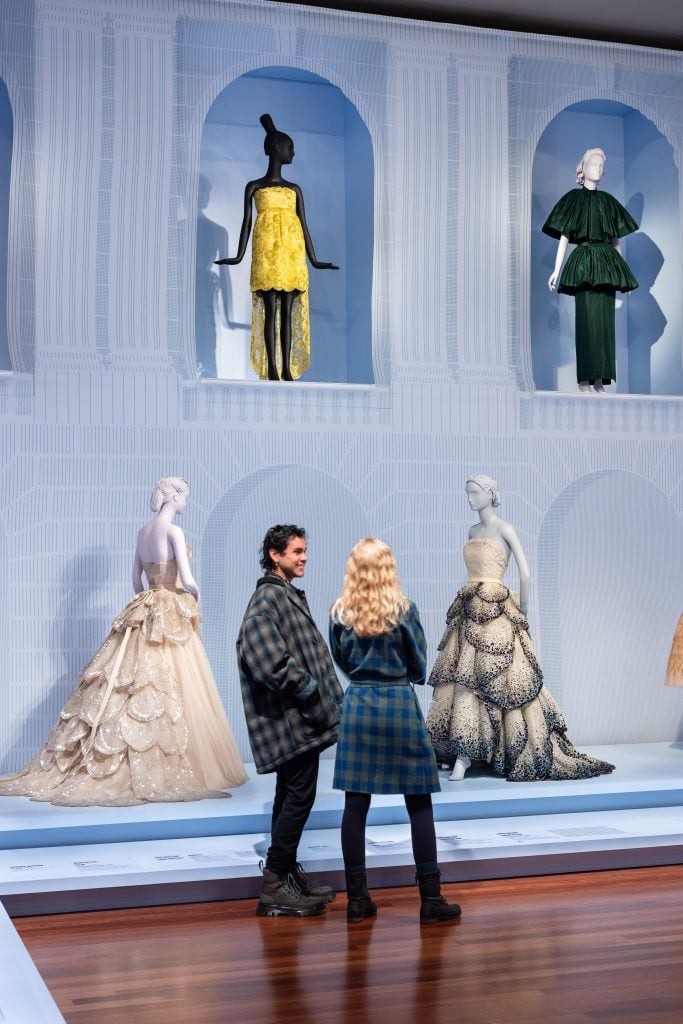
Installation view of “Fashioning San Francisco: A Century of Style” at de Young Museum. Photo: Gary Sexton, courtesy of the Fine Arts Museums of San Francisco.
Among the show’s highlights is “After the Ball,” a section devoted to a slew of extravagant gowns. At its center is a pair of diaphanous couture creations. The two dresses, Camerlengo explained, emerged from San Francisco manufacturers’ joint postwar bid to rejuvenate the city’s fashion industry. Following a trade agreement, France sent two Dior designs out to the West Coast for a publicity tour by the luxury department store I. Magnin & Company.
“Then the company gave them to the museum, noting their importance in preservation for future generations ” Camerlengo continued. “They said they considered them the pinnacle of fashion and creativity.”
Camerlengo also pointed out a 1985 design by Kaisik Wong, a sheer printed ensemble embellished with Chinese-inspired elements and paired with a highly structured lamé coat. The museum is home to the late artist’s archive, a trove of clothing, photographs, and ephemera acquired directly from his family with donor funds (the gift was exhibited at de Young’s 1995 retrospective, “True Couture: The Wearable Art of Kaisik Wong”).
That Wong’s outfit was selected as one of the A.R. try-ons is down to the “considerations of the technology,” Camerlengo said, which called for pieces that covered most of the wearer’s body. But more so, “he was a San Francisco designer,” she added, “so it’s a nice way to showcase what we preserve here as well.”
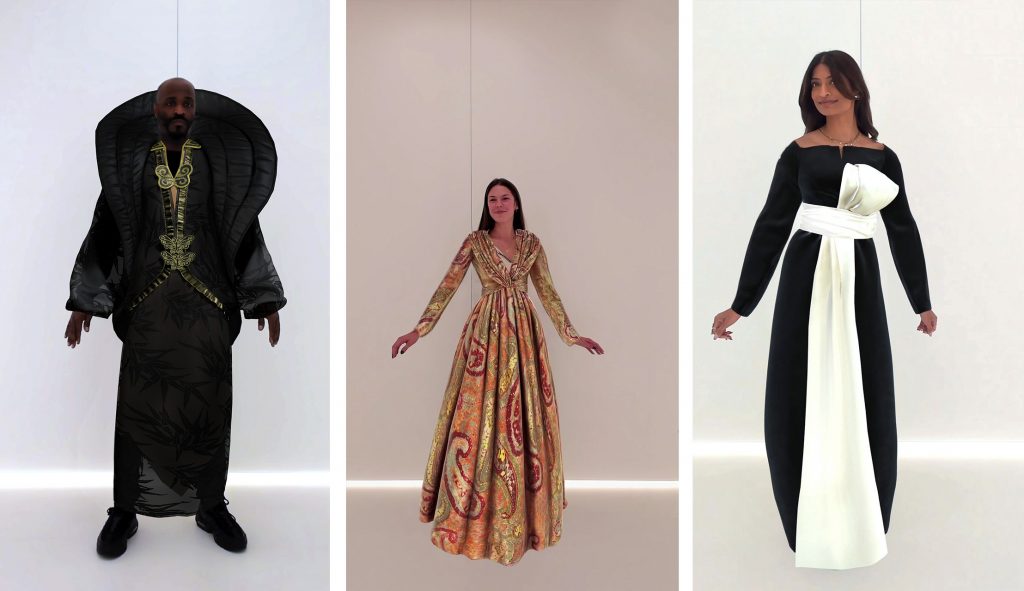
The Snap A.R. try-on activation at “Fashioning San Francisco: A Century of Style,” featuring models in designs [from left] by Kasik Wong, Valentino, and Yves Saint Laurent. Photos courtesy of Snap Inc.
The Snap and de Young teams then worked closely to create 3D versions of the chosen outfits. These were animated and loaded into the A.R. mirrors, which were custom designed for the museum environment.
“When it comes to building experiential moments, everything that we do is from the ground up. It’s never cut-and-paste,” Snap’s Jacques explained. “We want to talk to the people behind the scenes about their vision and how can Snap A.R. bring that vision to life.”
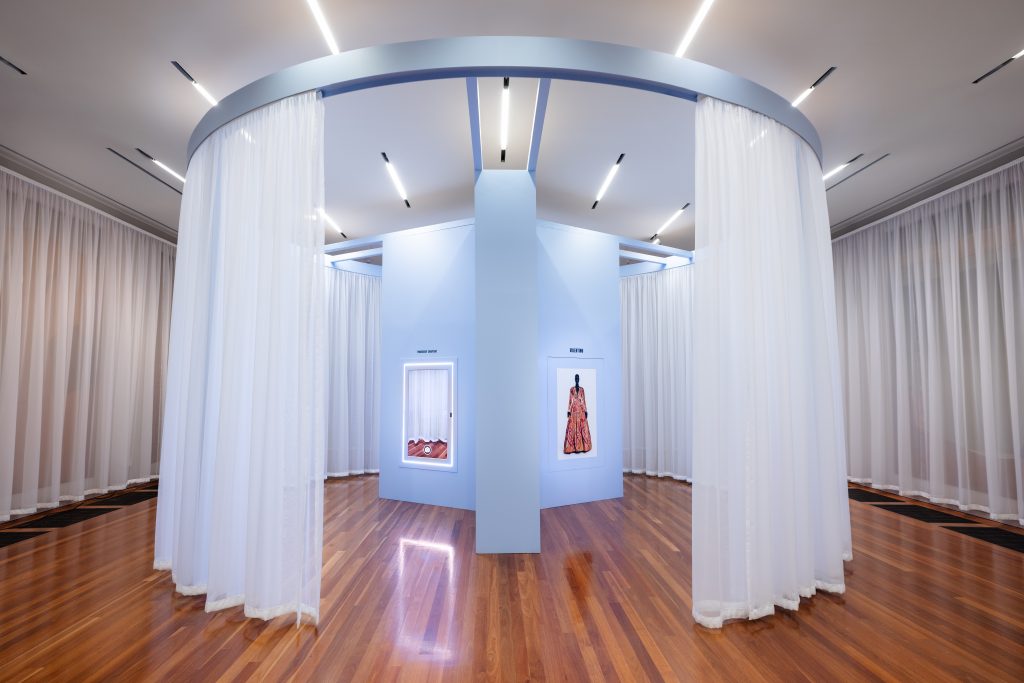
The A.R. try-on experience by Snap accompanying “Fashioning San Francisco: A Century of Style” at de Young Museum. Photo: Gary Sexton, courtesy of the Fine Arts Museums of San Francisco.
This is not Snap’s first rodeo within the museum or art space either. It has partnered with the L.A. County Museum of Art for its multi-part Monumental Perspectives project, and more recently, with the Louvre for its Egypt Augmented program. The company’s Snap A.R. Lens has likewise been leveraged by artists including Damien Hirst and Alex Israel.
Jacques won’t discuss the cost of building out an A.R. experience such as the one at “Fashioning San Francisco,” emphasizing instead the “synergy” between art and tech partners, and something way more valuable: cultural relevance. “We’re always seeking that,” she said.
In turn, fitting for a technology that powers a social media app, Snap’s A.R. has injected an element of play into what could be a static showcase. Audiences leave with the experience of participation and if not, the ultimate memento: a selfie, which they can snap as they pose in the virtual fashions.
“We want to create that experience so that when you leave the building, there’s an emotion attached to it. We want people to have fun and explore and just be, like, wow, I never even thought this could happen,” said Jacques. “I feel like people forget about the fun part.”
“Fashioning San Francisco: A Century of Style” is on view at de Young Museum, Golden Gate Park, 50 Hagiwara Tea Garden Drive, San Francisco, through August 11.